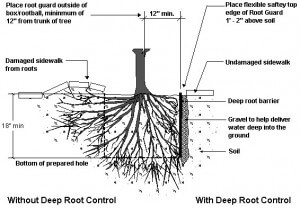As 4th of July preparations were well underway, we also experienced an unexpected haboob. This is defined as an intense dust storm. During thunderstorm formation, winds move in a direction opposite to the storm’s travel. Additionally, they move from all directions into the thunderstorm. When the storm collapses and begins to release precipitation, wind directions reverse, gusting outward from the storm and generally gusting the strongest in the direction of the storm’s travel. When these storms occur, we often see damage resulting in broken trees and branches littering streets and walkways.
 There are a couple of things that can be done to minimize personal and property damage as well as to minimize uprooting of the tree. If possible, before installation of the tree, encourage the roots to take deep root by installing a root barrier. This device will also protect sidewalks and nearby structures, as this diagram illustrates.The root barrier is made of a strong plastic material. It is used to line the perimeter of the planting hole. Once the roots reach the edge of the planting hole and encounter the barrier, they turn downward.
There are a couple of things that can be done to minimize personal and property damage as well as to minimize uprooting of the tree. If possible, before installation of the tree, encourage the roots to take deep root by installing a root barrier. This device will also protect sidewalks and nearby structures, as this diagram illustrates.The root barrier is made of a strong plastic material. It is used to line the perimeter of the planting hole. Once the roots reach the edge of the planting hole and encounter the barrier, they turn downward.
Another line of protection involves regular tree maintenance or pruning. When we prune or thin the tree’s canopy, it allows wind to pass through the tree more easily. For the most part, pruning involves lifting the branches to a height that people can comfortably walk under along with removing the end weight of the branches and reducing the crown.
There are many expert arborists that can assist you with a free assessment. If you would like our help, please feel free to contact us at info@xeriscapes.com or call our office at 602-252-6434.